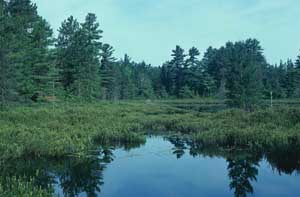|
|
 10 abandoned beaver pond DHJanzen100883.jpg high resolution
|
|
| Returning to the abandoned beaver pond in image DHJanzen100878.jpg and DHJanzen100879.jpg above, why had the pond been abandoned by its beaver family? The shrubby vegetation growing in the pond is Ericaceae. Essentially all Ericaceae have foliage that is both very rich in tannins (digestion inhibitors) and toxic alkaloids and other small nasty chemicals. All that low greenery is inedible to a beaver. The shorline is ringed with conifers - essentially all inedible to beaver owing to their high content of resins (and see image DHJanzen100902.jpg and DHJanzen100903.jpg below). Prior to beaver occpancy of the site, and construction of their dam many years before, among these two groups of inedibe woody plants would have been intermingled poplar, alders, willows, birch, maple and other fast-growing sun-loving broad-leafed saplings and trees. Essentially all of these were harvested by the beaver over about ten years of occupancy. The beaver family effectively starved itself out of the site, and moved elsewhere in the network of streams and rivers of which this is part. During that time, they probably generated 2-4 offspring every year, who, in the spring of their second year, left (were driven out) of the colony and attempted to establish their own new colonies elsewhere in other streams and small rivers (or ponds, such as the oxbow lake in the Mississippi in image DHJanzen100874.jpg above). It will require several decades for this site to again have enough food in it for a beaver colony to again establish (see below), and the consequent deepening pond drowning the Ericaceae and providing transport for the beaver as they search for woody plants to cut (and bring to the winter food supplies by the beaver house). | ||
back to lecture slides
or skip to: